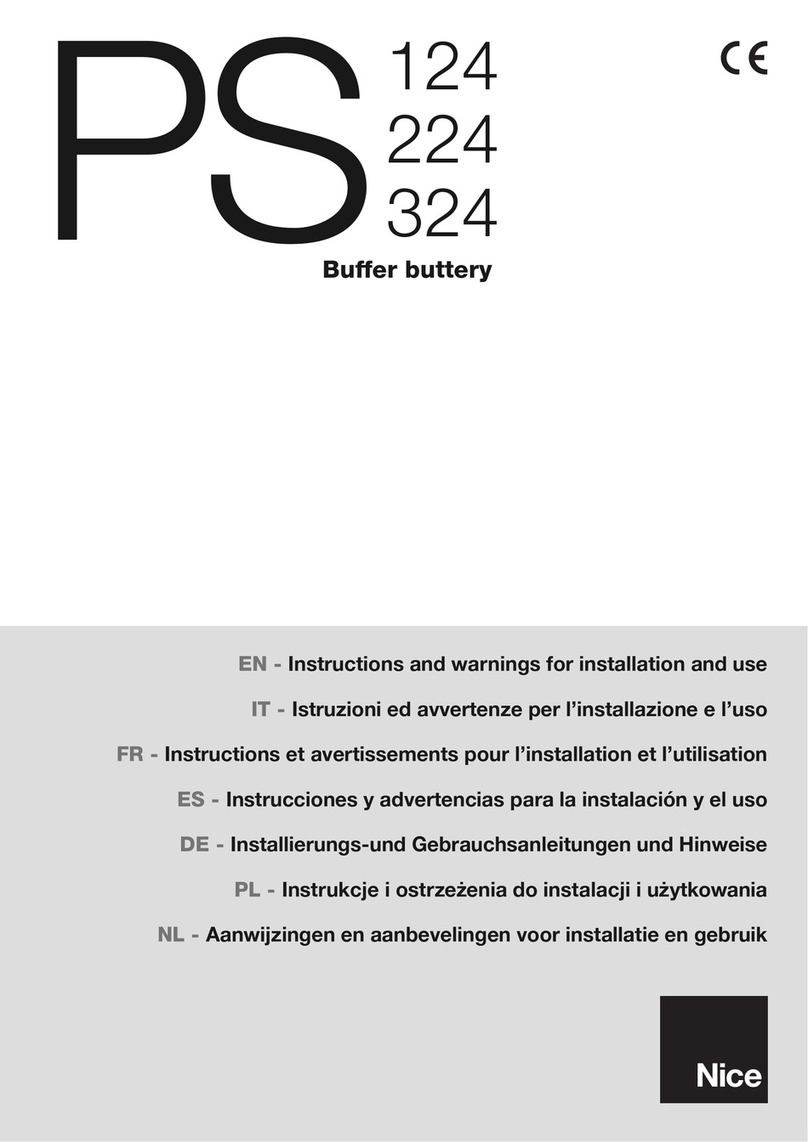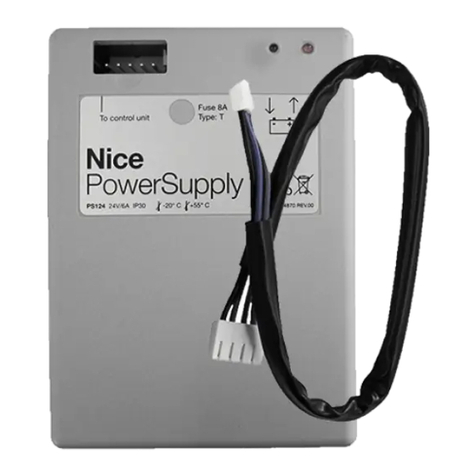6
La batterie tampon PS124 (Fig.1) peut être installée exclusivement
dans des automatismes pour portails avec armoires de commande
NICE; elle permet d’accumuler de l’énergie durant la période pen-
dant laquelle l’automatisme est alimenté par le secteur et de la res-
tituer en cas d’interruption de la tension de secteur (fonctionnement
tampon); elle permet environ une dizaine d’actionnements du portail
en l’absence de tension du secteur d’alimentation principal.
Suivant le type d’automatisme, quand la batterie tampon est en ser-
vice, les mouvements pourraient être effectués à la vitesse “lente”
même si on a sélectionné la vitesse “rapide”.
Avertissements:
•L’installation, l’essai de fonctionnement et la mise en service des auto-
matismes pour portes et portails doivent être effectués par du person-
nel qualifié et expérimenté qui devra se charger d’établir les essais pré-
vus en fonction des risques présents et de vérifier le respect de ce qui
est prévu par les lois, les normes et les réglementations.
•NICE ne répond pas des dommages résultant d’une utilisation
impropre du produit, différente de celle qui est prévue dans ce manuel.
•Le matériau de l’emballage doit être mis au rebut dans le plein respect
des normes locales.
•Éviter que la batterie tampon puisse être immergée dans l’eau ou dans
d’autres substances liquides. Si des substances liquides ont pénétré
à l’intérieur du dispositif, la déconnecter immédiatement l’automatisme
et s’adresser au service après-vente NICE; l’utilisation du dispositif
dans ces conditions peut constituer des situations de danger.
•Ne pas conserver la batterie tampon à proximité de sources de cha-
leur ni l’exposer à des flammes; ces actions peuvent l’endommager et
être la cause de problèmes de fonctionnement, incendie ou situations
de danger.
•Dans le cas de longues périodes d’inactivité, pour éviter le risque de
fuites de substances nocives de la batterie tampon, il est préférable de
la déconnecter de l’automatisme et de la conserver dans un lieu sec.
1) Description et application
2) Installation
Les opérations d’installation de la batterie tampon
PS124 doivent être effectuées en l’absence de tension
dans l’installation.
Utiliser le connecteur le plus étroit du côté de la batte-
rie tampon et le plus large du côté de l’armoire; lors de la
connexion des connecteurs, il n’est pas nécessaire de
respecter une polarité quelconque.
Pour l’installation de la batterie tampon PF124 se référer aux ins-
tructions figurant dans l’automatisme.
3) Vérification du fonctionnement et essai
Les vérifications suivantes doivent être faites immédiatement après
avoir connecté la batterie à l’armoire.
•Vérifier que la LED “L2” (Fig.1) est allumée, en indiquant ainsi que
la batterie fournit de l’énergie à l’installation. Vérifier que les
diverses LED sur l’armoire indiquent le fonctionnement correct de
cette dernière.
•Si les LED ne fonctionnent pas, la batterie est probablement com-
plètement à plat; il faut donc effectuer l’opération successive et
attendre quelques heures avec l’automatisme connecté au secteur
avant d’effectuer de nouveau la vérification du fonctionnement.
•Connecter l’automatisme au secteur et vérifier que la LED “L1”
(Fig.1) est allumée en indiquant ainsi que la batterie est en train de
se recharger.
•Effectuer au moins une manœuvre d’ouverture et de fermeture de
l’automatisme pour vérifier si tout fonctionne parfaitement en pré-
sence de la tension de secteur.
•Déconnecter l’automatisme de la tension de secteur; vérifier que la
LED “L2” (Fig.1) est allumée puis effectuer au moins une
manœuvre d’ouverture et de fermeture de l’automatisme pour véri-
fier si tout fonctionne parfaitement dans le cas de l’alimentation par
batterie.
N.B.: suivant le type d’automatisme, quand la batterie tampon est en
service, les mouvements pourraient être effectués à la vitesse “len-
te” même si on a sélectionné la vitesse “rapide”.
•Àla fin des essais, reconnecter l’automatisme au secteur.
1
L2L1





























